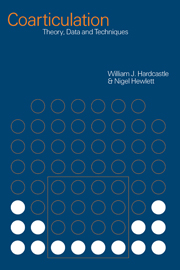Book contents
- Frontmatter
- Contents
- List of figures
- List of tables
- List of contributors
- Acknowledgments
- Introduction
- Part I Theories and models
- Part II Research results: components of the motor system for speech
- 3 Velopharyngeal coarticulation
- 4 Lingual coarticulation
- 5 Laryngeal coarticulation
- 6 Labial coarticulation
- 7 Lip and jaw coarticulation
- Part III Wider perspectives
- Part IV Instrumental techniques
- References
- Index
6 - Labial coarticulation
Published online by Cambridge University Press: 22 September 2009
- Frontmatter
- Contents
- List of figures
- List of tables
- List of contributors
- Acknowledgments
- Introduction
- Part I Theories and models
- Part II Research results: components of the motor system for speech
- 3 Velopharyngeal coarticulation
- 4 Lingual coarticulation
- 5 Laryngeal coarticulation
- 6 Labial coarticulation
- 7 Lip and jaw coarticulation
- Part III Wider perspectives
- Part IV Instrumental techniques
- References
- Index
Summary
Introduction
The labial system plays an important role in speech production: the lips act as primary or secondary articulators in the production of a number of segments. With respect to all other speech structures, the lips have the advantage of being readily observable, and the facial muscles responsible for lip movements that of being easily accessible. Moreover, while movements of the lower lip are usually the sum of the component jaw and lip movements, those of the upper lip can be considered completely independent of the movements and positions of other articulators, and so directly reflect articulatory and coarticulatory motor commands. The visibility and accessibility of the lips and their greater freedom from physiological constraints as compared to the tongue articulator, explain why early speech production models were based on the observation of lip gestures and their temporal organization (Kozhevnikov and Chistovich 1965) and why studies of labial coarticulation and the lip or jaw system are fundamental to shedding light on speech motor control and the function of synergistic and compensatory strategies of interarticulator coordination.
Labial articulation
Phonological description and articulatory measures
Vowels
The configuration of the lips in vowel production (represented in phonology by the feature Round) is one of the three primary dimensions along which vowels are classified, the other two being related to tongue configuration (represented by the features High and Back). The majority of languages do not make phonological use of the feature Round, since lip rounding is associated with tongue backness (Ladefoged and Maddieson 1990).
- Type
- Chapter
- Information
- CoarticulationTheory, Data and Techniques, pp. 144 - 163Publisher: Cambridge University PressPrint publication year: 1999
- 3
- Cited by

